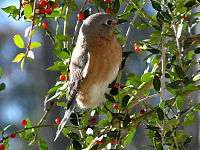Ilex vomitoria
| Ilex vomitoria | |
|---|---|
 | |
| Foliage and fruit | |
| Scientific classification | |
| Kingdom: | Plantae |
| (unranked): | Angiosperms |
| (unranked): | Eudicots |
| (unranked): | Asterids |
| Order: | Aquifoliales |
| Family: | Aquifoliaceae |
| Genus: | Ilex |
| Species: | I. vomitoria |
| Binomial name | |
| Ilex vomitoria Sol. ex Aiton | |
 | |
| Natural range | |
Ilex vomitoria, commonly known as yaupon or yaupon holly, is a species of holly that is native to southeastern North America.[1] The word yaupon was derived from its Catawban name, yopún, which is a diminutive form of the word yop, meaning "tree". Another common name, cassina, was borrowed from the Timucua language[2] (despite this, it usually refers to Ilex cassine).
Description
Yaupon holly is an evergreen shrub or small tree reaching 5–9 meters tall, with smooth, light gray bark and slender, hairy shoots. The leaves are alternate, ovate to elliptical with a rounded apex and crenate or coarsely serrated margin, 1–4.5 cm long and 1–2 cm broad, glossy dark green above, slightly paler below. The flowers are 5–5.5 mm diameter, with a white four-lobed corolla. The fruit is a small round, shiny, and red (occasionally yellow) drupe 4–6 mm diameter containing four pits, which are dispersed by birds eating the fruit. The species may be distinguished from the similar Ilex cassine by its smaller leaves with a rounded, not acute apex.[3][4][5][6][7]
Habitat and range
I. vomitoria occurs in the United States from Maryland south to Florida and west to Oklahoma [6] and Texas. A disjunct population occurs in the Mexican state of Chiapas.[1] It generally occurs in coastal areas in well-drained sandy soils, and can be found on the upper edges of brackish and salt marshes, sandy hammocks, coastal sand dunes, inner-dune depressions, sandhills, maritime forests, nontidal forested wetlands, well-drained forests and pine flatwoods.[3]
Ecology

The fruit are an important food for many birds, including Florida duck, American black duck, mourning dove, ruffed grouse, bobwhite quail, wild turkey, northern flicker, sapsuckers, cedar waxwing, eastern bluebird, American robin, gray catbird, northern mockingbird, and white-throated sparrow. Mammals that eat the fruit include nine-banded armadillo, American black bear, gray fox, raccoon and skunks. The foliage and twigs are browsed by white-tailed deer.[3]
Cultivation and uses
Native Americans used the leaves and stems to brew a tea, commonly thought to be called asi or black drink for male-only purification and unity rituals. The ceremony included vomiting, and Europeans incorrectly believed that it was Ilex vomitoria that caused it (hence the Latin name). The active ingredients, like those of the related yerba mate and guayusa plants, are actually caffeine and theobromine,[8][9] and the vomiting either was learned or resulted from the great quantities in which they drank the beverage coupled with fasting.[3][10] Others believe the Europeans improperly assumed the black drink to be the tea made from Ilex vomitoria when it was likely an entirely different drink made from various roots and herbs and did have emetic properties.[11]
Ornamental
Ilex vomitoria is a common landscape plant in the Southeastern United States. The most common cultivars are slow-growing shrubs popular for their dense, evergreen foliage and their adaptability to pruning into hedges of various shapes. These include:
- 'Folsom Weeping' – weeping cultivar
- 'Grey's Littleleaf'/'Grey's Weeping' – weeping cultivar
- 'Nana'/'Compacta' – dwarf female clone usually remaining below 1 m in height.
- 'Pride of Houston' – female clone similar to type but featuring improvements in form, fruiting, and foliage.
- 'Schilling's Dwarf'/'Stokes Dwarf' – dwarf male clone that grows no more than 0.6 m tall and 1.2 m wide.[12]
- 'Will Flemming' – male clone featuring a columnar growth habit.
See also
- Ilex paraguariensis or yerba mate – a caffeinated holly native to subtropical South America.
- Ilex guayusa or guayusa – a caffeinated holly native to the Ecuadorian Amazon Rainforest.
- Kuding – a Chinese tisane made from I. kudingcha
References
| Wikimedia Commons has media related to Ilex vomitoria. |
| Wikispecies has information related to: Ilex vomitoria |
- 1 2 "Taxon: Ilex vomitoria Sol. ex Aiton". Germplasm Resources Information Network. United States Department of Agriculture. 2011-05-09. Retrieved 2011-09-19.
- ↑ Cutler, Charles L. (2000). O Brave New Words!: Native American Loanwords in Current English. University of Oklahoma Press. pp. 10, 163, 215. ISBN 978-0-8061-3246-4.
- 1 2 3 4 "Yaupon Ilex vomitoria" (PDF). USDA Plant Guide.
- ↑ "Florida's Hollies". Florida Department of Environmental Protection.
- ↑ Martin, C.O.; Mott, S.P. (1997). "Section 7.5.10 Yaupon (Ilex vomitoria)". U.S. Army Corps of Engineers Wildlife Resources Management Manual (PDF). Vicksburg, MS: U.S. Army Engineer Waterways Experiment Station. Technical Report EL-97-16.
- 1 2 "Ilex vomitoria". Oklahoma Biological Survey.
- ↑ Bioimages: Ilex vomitoria
- ↑ Wilford, JN (8 August 2012). "Ancient Energy Boost, Brewed From Toasted Leaves and Bark". New York Times.
- ↑ Crown PL, Emerson TE, Gu J, Hurst WJ, Pauketat TR, Ward T (August 2012). "Ritual Black Drink consumption at Cahokia". Proc. Natl. Acad. Sci. U.S.A. 109 (35): 13944–9. doi:10.1073/pnas.1208404109. PMC 3435207
 . PMID 22869743.
. PMID 22869743. - ↑ Hudson, C. M. (1976). The Southeastern Indians. University of Tennessee Press ISBN 0-87049-248-9.
- ↑ Gibbons, E. (1964). Stalking the Blue-eyed Scallop. David McKay. ISBN 0-911469-05-2.
- ↑ Flint, Harrison Leigh (1997). Landscape Plants for Eastern North America (2 ed.). John Wiley and Sons. pp. 282–283. ISBN 978-0-471-59919-7.